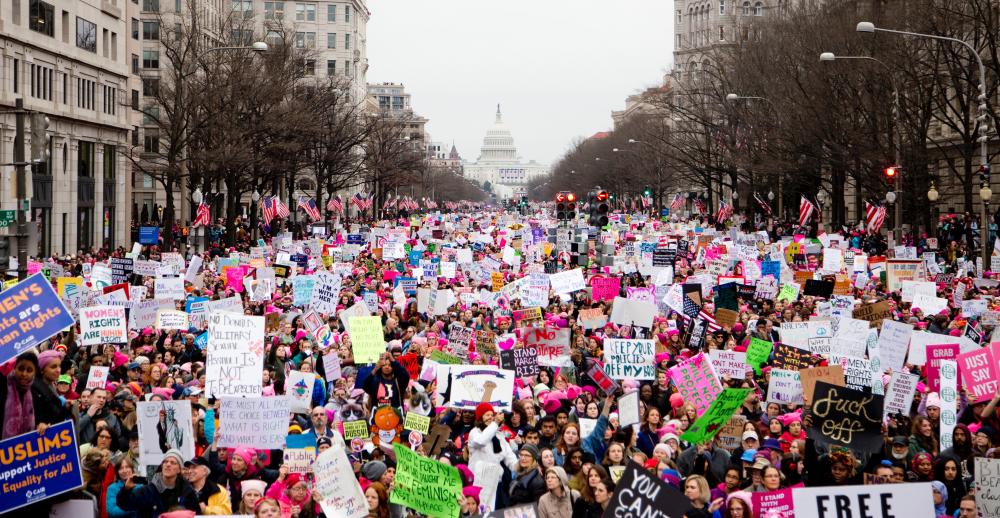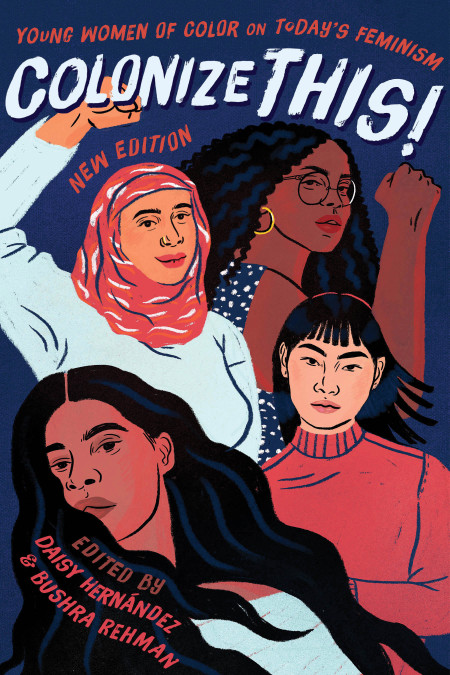Interviews
How Has Intersectional Feminism Changed in the Past 18 Years?
Daisy Hernández and Bushra Rehman, editors of "Colonize This!," on updating a landmark anthology for the next generation of activists

In 2002, when I was a relatively recent college graduate, I found a book that served both as a complement and counterpoint to the (white) feminist theory I had spent years studying in college. It was Colonize This! Young Women of Color on Today’s Feminism edited by Daisy Hernández and Bushra Rehman, a collection of essays about the politics of feminism and a scathing, pointed, and powerful commentary on then-contemporary definitions of feminism.
Hernández and Rehman assembled a roster of young feminists who addressed everything from gentrification to activism and organizing; from the body, reproductive rights, and mental health to beauty, sexual harassment, and rape––all through an intersectional lens at a time when the word “intersectional” was rarely heard outside of academic spaces.
Seventeen years on, this landmark anthology has been re-edited and republished with nine new essays by a new generation of young feminists who take on trans motherhood, serve as abortion doulas, organized on the morning after Election Day 2016, live and make art as Diné women, and more.
“What does feminism look like for young women of color who grew up with the first Black president? With a more visible transgender community? With social media platforms?” asks Hernández, a creative writing teacher at Miami University of Ohio, in her introduction to the second edition. “I was hungry to read the stories of these young women of color.” Adds poet, novelist, and teaching artist Rehman, “It is the youth, and has always been the youth, who have carried the fire and the light forward.”
I spoke with Hernández and Rehman about the genesis of the new edition of Colonize This!, youth feminist discourse, the “Squad,” and the weight of feminist history.
Pooja Makhijani: What compelled you to re-edit/reissue Colonize This!, given that it is, perhaps, a defining feminist text of a generation?
Bushra Rehman: We were so amazed to see how the impact of the first edition was so powerful and far-reaching. Over the last two decades, we’ve been told by numerous readers that Colonize This! changed their lives. It brought them to feminism and activism, helped them feel less alone, inspired them to heal their relationships with their families, and empowered them to create lives on their own terms while creating meaningful communities.
When we did the first edition, it was in the midst of 9/11. This moment feels different. Not only are we again under threat, but we are also more equipped than ever to gather and organize. Our numbers are larger and the creativity and power we are seeing in today’s youth-led movements is deeply inspiring.
This moment in our country is so deeply disturbing. As people of color, our rights, our very humanity is being challenged in ways that feel more dangerous than they did 20 years ago. At the same time, the power we hold as people of color in this country also feels stronger. For all these reasons, this felt like the right time to put out a new edition. Both to document the amazing activism happening and to inspire more. The first edition inspired a generation of activists and we need all the inspiration we can get now to stand up for what we believe.
This felt like the right time to put out a new edition. Both to document the amazing activism happening and to inspire more.
It’s so hard to explain the lack of connectedness we felt before social media. To find friends and activists you had to find them in person and through books. This book was a message in a bottle that was sent out from us to the world; I was truly in awe at how quickly it was passed on and how it has lasted. That said, I also knew that we had not been able to cover certain topics at the time in 2001 and that this [republication] was a chance to remedy that.
PM: How do you hope these new essays broaden your original vision? And how did you source new work?
Daisy Hernández: We approached writers we knew in some cases. I knew I wanted Andrea Pino and Amber Taylor and Sonia Guiñansaca and Jamilah King. I was familiar with their creative work and activism and I knew they could speak to sexual assault on campus, coming of age during Obama, or being undocumented. We also brainstormed a list of topics that were specific to a new generation of women of color, like online bullying and social media. Other writers found us, which was incredible. I also wanted to honor the spirit of the first edition. I wanted to have writers who had never been published along with women of color who already have platforms. We added nine new essays and it really came together in incredible ways.
BR: I knew I wanted to include the stories of transgender writers [who were not represented in the first edition] and mothers, and stories about reproductive justice. We now have essays by writers on all of these topics, including Luna Merbruja’s, “Resisting Sterilization & Trans Motherhood,” which is about motherhood, trans justice and reproductive justice.
PM: What you hope readers will gain by rereading the original essays alongside the new ones?
DH: I hope they will feel inspired by both the original essays and the new ones. So many of the original essays speak to today, like Taigi’s [Smith] essay on gentrification [“What Happens When Your Hood Is the Last Stop on the White Flight Express”]. The 2002 edition made a lot of readers feel a sense of home and belonging. I think [the original] essays still do that. When I sat down to read the essays from the first edition, I immediately felt a sense of being with like-minded mujeres. I think readers today will feel that too.
BR: Also for second-generation children, many of the experiences are exactly the same: the complicated relationships with their families, with coming out, with being the first to go to college, with trying to find a way to move through the liminal space of multiple cultures, of dealing with racism, with being told to go back to where you came from. It’s worse now as we have the president saying it, but then we also have “The Squad” [the quartet of congresswomen of color who President Trump told to “go back home” in July 2019].
DH: “The Squad” is not a group we could have imagined in 2002, but we were working for it.
PM: What has changed in youth feminist discourse since the original anthology was published?
DH: I think part of what has changed are concepts of gender. We came out of “women’s studies”; most folks now are coming out of “women’s and gender studies.” We are now talking “gender nonconformist” and “cisgender.”
There’s more communication across borders thanks to technology. That has also changed discourse. In the Latinx community, folks are talking about “x” and whether it does or does not translate in Spanish.
I think today women are more ready and insistent on working inside the belly of the beast. “The Squad” comes to mind, but also my sister and others working on local elections.
I think today women are more ready and insistent on working inside the belly of the beast.
BR: For me it’s been amazing to see how young Muslim women, who lived under the shadow of 9/11, have moved forward with great strength, community building, and pride. I agree with Daisy; I love how fluid this new generation is when it comes to gender and sexuality.
DH: But there is so much continuity, too. Young women of color still negotiating culture and sexuality, and our reproductive rights still being challenged in nightmarish ways. I still think young feminists of color are looking for their community.
BR: And the continuity of the idea of writing as a practice, and creating art that is radical, powerful, and healing. All of the contributors [to both editions] are people who have found writing as the secret door.
PM: What did you learn from your new contributors?
BR: A big shift for me was becoming a mother and, when I did, I realized how much motherhood was a feminist issue that I knew nothing about. This was an effect of second wave feminism on me. I just thought I could not have a child and continue to do the work I loved. When I did have a child, I realized how intense the misogyny of our patriarchal American culture seeps into every aspect of choosing to get pregnant (or not) choosing the ways you would like to give birth (or not) and the ways mothers are continually judged and held up to an impossible standard, especially given the lack of institutional support. It’s patriarchy at its finest, meaning its worst.
Also, the “Me Too” movement has been so deeply inspiring. I am continually inspired by youth-led movements like these and March for Our Lives, Black Lives Matter, and She Has a Name. There is so much hope. I am happy to follow in their footsteps.
DH: Feminism for me has always been a way of looking at the world and it’s changed with me. So in my twenties, feminism was about being queer and Latina and negotiating with family. Then feminism started to help me see how prescribed gender roles intersect with race and dictate how Black and Brown and white boys can and do move through the world. I started to see racial violence’s relationship with gender .
Now I’m thinking about the border and what’s happening there to families, so feminism is about how I see questions of citizenship and claims to places and denials of rights.
PM: For many women of color my age, Colonize This! was one of the first surveys of feminism as practiced by women of color. You both reflect on This Bridge Called My Back Writings by Radical Women of Color edited by Cherríe Moraga and Gloria E. Anzaldúa, also a seminal feminist text. Did the history of the importance of Colonize This! weigh on you as you edited the second edition? If so, how do you carry that weight?
DH: The history was definitely very present for me. That’s what made it important for me that we have unpublished writers in the new edition. I wanted the book to be a way for these women of color [the new contributors] to have their voices amplified among readers. I do think it might’ve been harder for the writers than it was for us. They were creating new work that would go into the anthology that they had grown up with!
The benefit of being a little older is that I felt comfortable with the fact that we weren’t going to produce a perfect new edition. This is what I tell women of color now: growing older is so good for us! You become more confident in who you are and what you’re doing. And you have more friends and community than you did when you were younger. I got so much love and support from friends for this new edition, so that definitely carried me through any doubts.
BR: I see the book as a tool. There are so many people who shared with me that it brought them to activism and I feel we need all hands on deck right now.
PM: As “seasoned” feminists, do you feel an obligation to mentor young women of color? If so, how does that manifest?
DH: I don’t feel an obligation to mentor. I feel an incredible joy and necessity in mentoring. Mentoring younger women of color feeds me intellectually, spiritually, and creatively.
BR: It’s not an obligation. It’s simply a way of life that I’ve had since I was young myself. I’ve always been an elder sibling, and I was already an elder in the South Asian activist community for teens when I was barely past my teen years.
DH: Young women of color become mentors very early. We have to do it that way. We can’t wait for others. And we can’t wait to feel qualified. We didn’t feel qualified to work on the first edition, but we did it because we needed the book.
BR: Not feeling “qualified” was something I had to make peace with. I didn’t want to be seen as a spokesperson for WOC feminism since it is so multilayered and complicated. I was simply searching like everyone else. On this journey, all inspired by the first desire, which was to write and be a writer, I met Daisy and all of these amazing women of color activists. We wanted Colonize This! to be a way to bring the stories of these writers and activists to everyone else who was also searching. I believe we’ve done it again.









